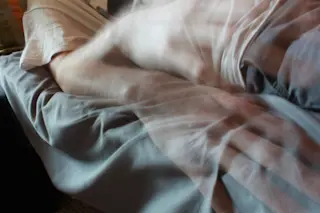A wiry man in his late 30s hangs near the top of a 40-foot wall, the toes of his climbing shoes barely gripping the sheer face. He clings with his left hand and pauses, swinging his right arm to the side, loosening the muscles. Then he raises his head and lunges, thrusting his right hand above him and catching a rock hold with his fingertips. With a few more moves he arrives at the top. Under normal circumstances this extreme rock climber would be worth watching. But what makes his effort even more remarkable is that he happens to be blind. Born with retinoschisis, a rare disease akin to macular degeneration, Erik Weihenmayer was sightless by age 13. Even so, he continued to pursue his dream of mountaineering, and he succeeded: In 2001 he became the first—and to date the only—blind climber to summit Mount Everest. Today he is climbing ...
The Blind Climber Who "Sees" With His Tongue
Erik Weihenmayer's BrainPort translates images into electrical signals.
More on Discover
Stay Curious
SubscribeTo The Magazine
Save up to 40% off the cover price when you subscribe to Discover magazine.
Subscribe












